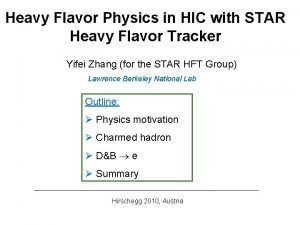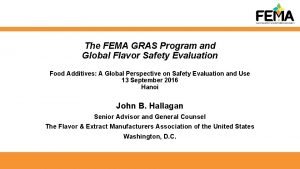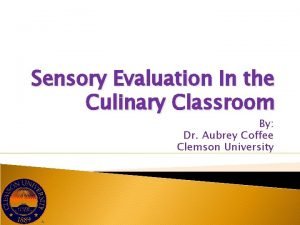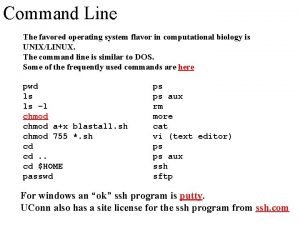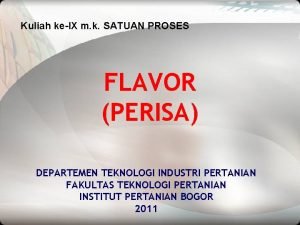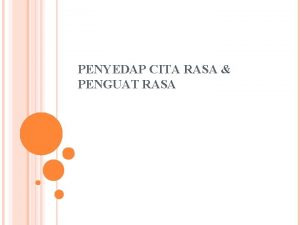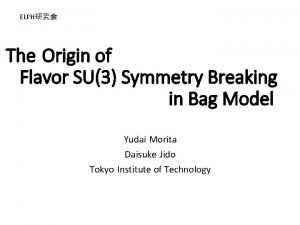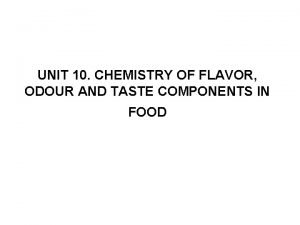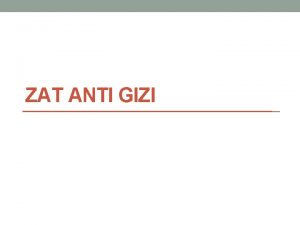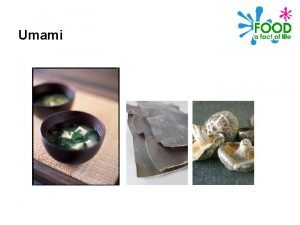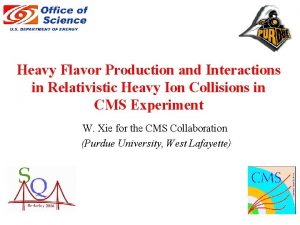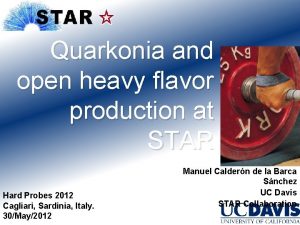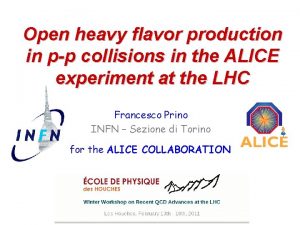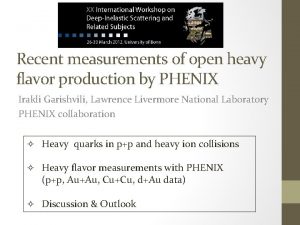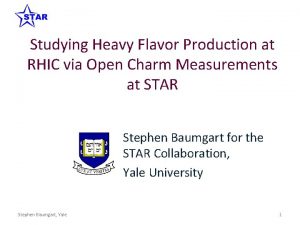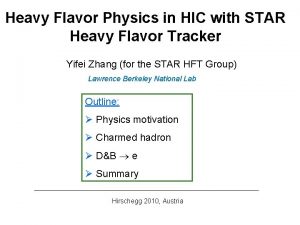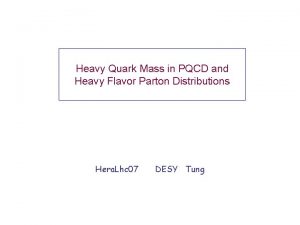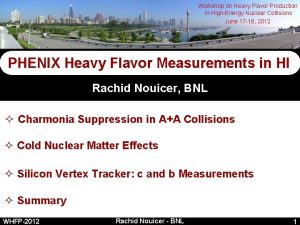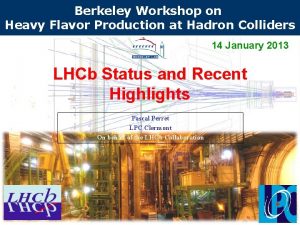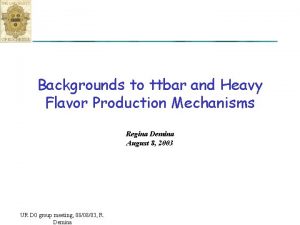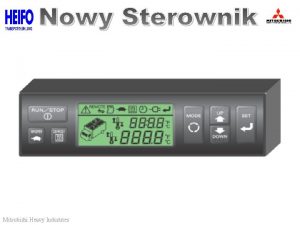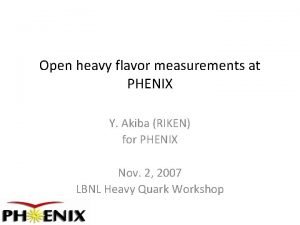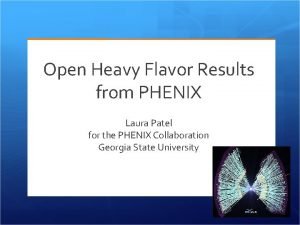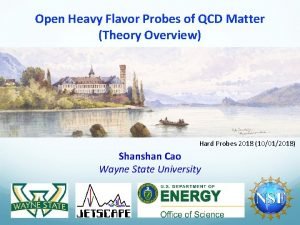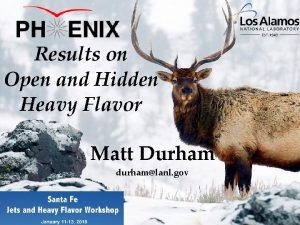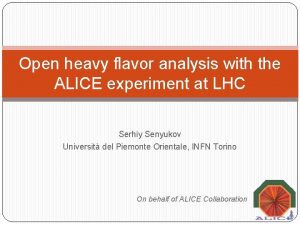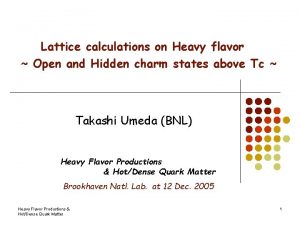Open Heavy Flavor Production in pp d Au








![PHENIX PRELIMINARY 3 1/TABEd. N/dp [mb Ge. V -2] AB PHENIX PRELIMINARY 1/TABEd. N/dp PHENIX PRELIMINARY 3 1/TABEd. N/dp [mb Ge. V -2] AB PHENIX PRELIMINARY 1/TABEd. N/dp](https://slidetodoc.com/presentation_image_h2/a9a32d8e98d8d81baf1e3e92d6b4958d/image-9.jpg)













- Slides: 22

Open Heavy Flavor Production in pp, d. Au and Au. Au Collisions at √s. NN =200 Ge. V Xiaorong Wang for PHENIX collaboration New Mexico State University X. R. Wang, PANIC, Santa Fe, 2005 1

Outline n n n Physics motivation Experimental techniques “Prompt muons” and “Non-photonic” electron results from pp and d. Au collisions ¨ Nuclear modification factor Rd. Au “Non-photonic” electron results from Au+Au collisions ¨ Nuclear modification factor RAA ¨ Electron elliptic flow Summary & outlook 2 X. R. Wang, PANIC, Santa Fe, 2005

Physics Motivation: n pp collisions: Provide the critical test for p. QCD calculations of heavy-quark production n d. Au collisions: probe cold nuclear medium effects Gluon saturation/CGC at forward rapidity (small x) ¨ Coherent multiple scattering and XB rescaling ¨ n Au. Au collisions: probe hot and high density matter effects “dead cone” effect: charm quark small energy loss (in vacuum) ¨ Heavy quark energy loss in medium ¨ suppression pattern: Little for B, moderate for c, and large for light q. RAA(e) > 0. 5 3 X. R. Wang, PANIC, Santa Fe, 2005

PHENIX detector Electrons: central arms |η| < 0. 35, p > 0. 2 Ge. V/c Muons: muon arms 1. 2 < |η| < 2. 4, p > 2 Ge. V/c p 0 e+ D*0 K+ - 4 X. R. Wang, PANIC, Santa Fe, 2005

Analysis Techniques: (non-photonic e) n n Two complimentary analysis techniques for signal extraction ¨ “Cocktail subtraction” ¨ “Converter subtraction” Both analyses clearly show an excess “non-photonic” electron signal attributed to heavy flavor decays Signal/Background Run 04: X=0. 4% S/B > 1 for p. T > 1 Ge. V/c Run 02: X=1. 3% 5 X. R. Wang, PANIC, Santa Fe, 2005

Analysis Techniques: (prompt muon) ¨ Punch-through hadrons: Data driven method to Estimate attenuation ¨ Decay muons: Vertex distribution analysis Muon detector number of tracks Prompt µ background subtraction Prompt+de cay muons Hadron Gap 2 Gap 3 Gap 4 p, K Decay muons Punch-through hadrons Prompt muons absorber ? 6 X. R. Wang, PANIC, Santa Fe, 2005

p+p at √s = 200 Ge. V: Final Non-photonic e & Preliminary Prompt Invariant Cross section Priliminary Muon spectra and electron spectra are similar over the observed p. T range… 7 X. R. Wang, PANIC, Santa Fe, 2005

Comparison to Theory FONLL: Fixed Order next-to-leading order terms and Next-to-Leading-Log large p. T resummation. PRELIMINARY FONLL and PYTHIA calculation is under predicted PHENIX electron data. The discrepancy is even larger at forward rapidity, possibly due to the rapidity dependence of cross section. 8 X. R. Wang, PANIC, Santa Fe, 2005
![PHENIX PRELIMINARY 3 1TABEd Ndp mb Ge V 2 AB PHENIX PRELIMINARY 1TABEd Ndp PHENIX PRELIMINARY 3 1/TABEd. N/dp [mb Ge. V -2] AB PHENIX PRELIMINARY 1/TABEd. N/dp](https://slidetodoc.com/presentation_image_h2/a9a32d8e98d8d81baf1e3e92d6b4958d/image-9.jpg)
PHENIX PRELIMINARY 3 1/TABEd. N/dp [mb Ge. V -2] AB PHENIX PRELIMINARY 1/TABEd. N/dp 3 [mb Ge. V 1/T -2] AB PHENIX PRELIMINARY 1/TABEd. N/dp 3 [mb Ge. V-2] 1/TABEd. N/dp 3 [mb Ge. V 1/T -2 AB] d+Au at √s. NN = 200 Ge. V: Non-photonic e± PHENIX PRELIMINARY “binary scaling” at mid-rapidity 9 X. R. Wang, PANIC, Santa Fe, 2005

d. Au at √s = 200 Ge. V: Prompt at Forward & Backward Au going d going Suppression in forward rapidity; Enhancement in backward rapidity; Different from central rapidity result!! Cold nuclear medium effects are significant: 1) Intrinsic Shadowing; 2) coherent multiple scattering; 3) 3) initial state energy loss; … X. R. Wang, PANIC, Santa Fe, 2005 10

Au. Au at √s = 200 Ge. V: Non-photonic e n n Non-photonic : Inclusive Curves: Binary scaled p+p reference n Clear high p. T suppression developing towards central collisions 11 X. R. Wang, PANIC, Santa Fe, 2005

Nuclear Modification Factor RAA 12 X. R. Wang, PANIC, Santa Fe, 2005

Comparison with Theory (1) q = 0 Ge. V 2/fm n In central collisions, RAA <<1 at high pt, providing clear evidence for strong medium effect; n Data favor models with large parton densities and strong coupling (4) d. Ng / dy = 1000 (2) q = 4 Ge. V 2/fm (3) q = 14 Ge. V 2/fm Theory curves (1 -3) from N. Armesto, et al. , PRD 71, 054027 (4) from M. Djordjevic, M. Gyullasy, S. Wicks, PRL 94, 112301 13 X. R. Wang, PANIC, Santa Fe, 2005

Open Charm Flow Theory: Greco, Ko, Rapp: PLB 595 (2004) 202 n Significant anisotropy observed for non-photonic electrons ¨ ¨ n Charm flow? Hadronization? Indication for reduction of v 2 at p. T > 2 Ge. V/c ¨ Bottom contribution? ? 14 X. R. Wang, PANIC, Santa Fe, 2005

Summary & outlook n n PHENIX measured production of non-photonic e at mid-rapidity and prompt at forward/backward rapidities in p+p, d+Au and Au+Au collisions at √s. NN = 200 Ge. V. For pp collisions: Non-photonic e p. T spectra at y = 0 and prompt p. T spectra at y = 1. 65 are similar. ¨ FONLL or PYTHIA 6. 205 are under predicted Non-photonic e production at middle rapidity. The discrepancy is even larger for prompt at forward rapidity. ¨ n For d. Au collisions: Middle rapidity follows binary scaling within errors. A suppression in forward rapidity of prompt muon production is observed. It is consistent with CGC and power correction pictures. ¨ Observation of enhancement at backward rapidity needs more theoretical investigation. Anti-shadowing and recombination could lead to such enhancement. ¨ ¨ n For Au. Au collisions: Nuclear modification factor RAA shows a strong suppression of the electrons at high p. T in Au+Au collisions. Observed RAA favors models with large parton densities and strong coupling ¨ Significant anisotropy observed for non-photonic electrons at y=0. ¨ Ongoing analysis: Au. Au prompt muon, prompt muon v 2 at y=2. ¨ n PHENIX silicon vertex detector will enable us to directly measure open charm. X. R. Wang, PANIC, Santa Fe, 2005 15

Backup 16 X. R. Wang, PANIC, Santa Fe, 2005

Open Charm Flow n Significant anisotropy observed for nonphotonic electrons Charm flow? ¨ Hadronization? ¨ n Indication for reduction of v 2 at p. T > 2 Ge. V/c ¨ n Theory: Greco, Ko, Rapp: PLB 595 (2004) 202 Bottom contribution? ? The shape at low p. T agrees with electron v 2 from D-meson decays assuming the shape of v 2 (D) proportional to v 2 (p) v 2 (D) = 0. 6 v 2 (p) v 2 (D) = 0. 3 v 2 (p) 17 X. R. Wang, PANIC, Santa Fe, 2005

Run 02 Au+Au total cross section vs Ncoll S. S. Adler, et al. , PRL 94 082301 Binary scaling of total open charm yield 18 X. R. Wang, PANIC, Santa Fe, 2005

Analysis Techniques: (semi-lepton channel) n non-photonic e: “Cocktail subtraction” ¨ “Converter subtraction” ¨ n Prompt µ: ¨ Punch-through hadrons: Data driven method to Estimate attenuation ¨ Muon detector Decay muons: Vertex dependent analysis p, K Decay muons Punch-through hadrons absorber Prompt muons ? 19 X. R. Wang, PANIC, Santa Fe, 2005

Sources of prompt muons (p. T> 0. 9 Ge. V) (determined from Pythia) D± ±, … , c+ +, charge asymmetric B ± ± * + q q * + - charge symmetric J/ , … + , , + - 20 X. R. Wang, PANIC, Santa Fe, 2005

Analysis Techniques: prompt muon n “Prompt” muons from semi-leptonic decays Ninclusive= Nprompt + (Npunch-through + Ndecay-muon) hadrons: n Data driven method: Estimate attenuation ¨ Decay muons • n Vertex dependent number of tracks ¨ Punch-through Prompt+de cay muons Hadron Gap 2 Gap 3 Gap 4 21 X. R. Wang, PANIC, Santa Fe, 2005

Analysis Techniques: Muons from hadron decay Muons from light hadron decay can be separated by vertex distribution analysis Muon detector p, K Decay muons Punch-through hadrons absorber Prompt muons North arm ? The normalized muon event vertex distribution 22 X. R. Wang, PANIC, Santa Fe, 2005
 Charm mesom
Charm mesom Apa yang dimaksud dengan pre production process
Apa yang dimaksud dengan pre production process Ratey method
Ratey method Open innovation open science open to the world
Open innovation open science open to the world Flavor vs taste
Flavor vs taste Does salt lose its flavor
Does salt lose its flavor Fema gras list
Fema gras list Flavor pyramid
Flavor pyramid Operating system flavor
Operating system flavor Contoh flavor enhancer
Contoh flavor enhancer Pengertian penguat rasa
Pengertian penguat rasa Contoh flavor sintetis
Contoh flavor sintetis Su(3) flavor symmetry
Su(3) flavor symmetry Cocktail flavor wheel
Cocktail flavor wheel Taste vs flavor
Taste vs flavor Contoh zat non gizi
Contoh zat non gizi Off flavor cerveza
Off flavor cerveza Mc flavor fries
Mc flavor fries Chapter 10 lipids nature's flavor enhancers
Chapter 10 lipids nature's flavor enhancers Foods with umami flavor
Foods with umami flavor Komponen non gizi jenis zat warna dan flavor terdiri dari
Komponen non gizi jenis zat warna dan flavor terdiri dari Off delay timer symbol
Off delay timer symbol Open hearts open hands
Open hearts open hands
